About DataHub Search
The search bar is an important mechanism for discovering data assets in DataHub. From the search bar, you can find Datasets, Columns, Dashboards, Charts, Data Pipelines, and more. Simply type in a term and press 'enter'.
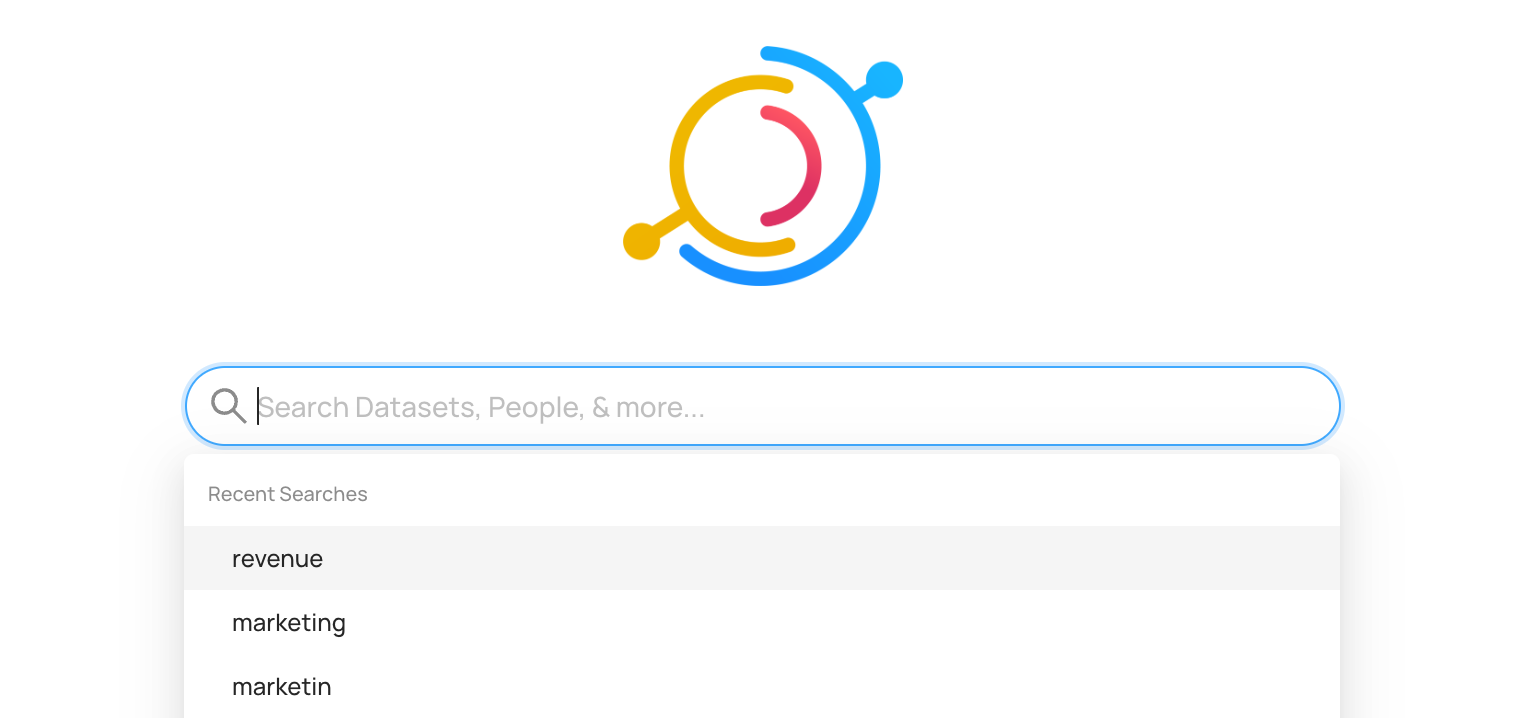
Advanced queries and the filter sidebar helps fine tuning queries. For programmatic users Datahub provides a GraphQL API as well.
Search Setup, Prerequisites, and Permissions
Search is available for all users. Although Search works out of the box, the more relevant data you ingest, the better the results are.
Using Search
Searching is as easy as typing in relevant business terms and pressing 'enter' to view matching data assets.
By default, search terms will match against different aspects of a data assets. This includes asset names, descriptions, tags, terms, owners, and even specific attributes like the names of columns in a table.
Filters
The filters sidebar sits on the left hand side of search results, and lets users find assets by drilling down. You can quickly filter by Data Platform (e.g. Snowflake), Tags, Glossary Terms, Domain, Owners, and more with a single click.
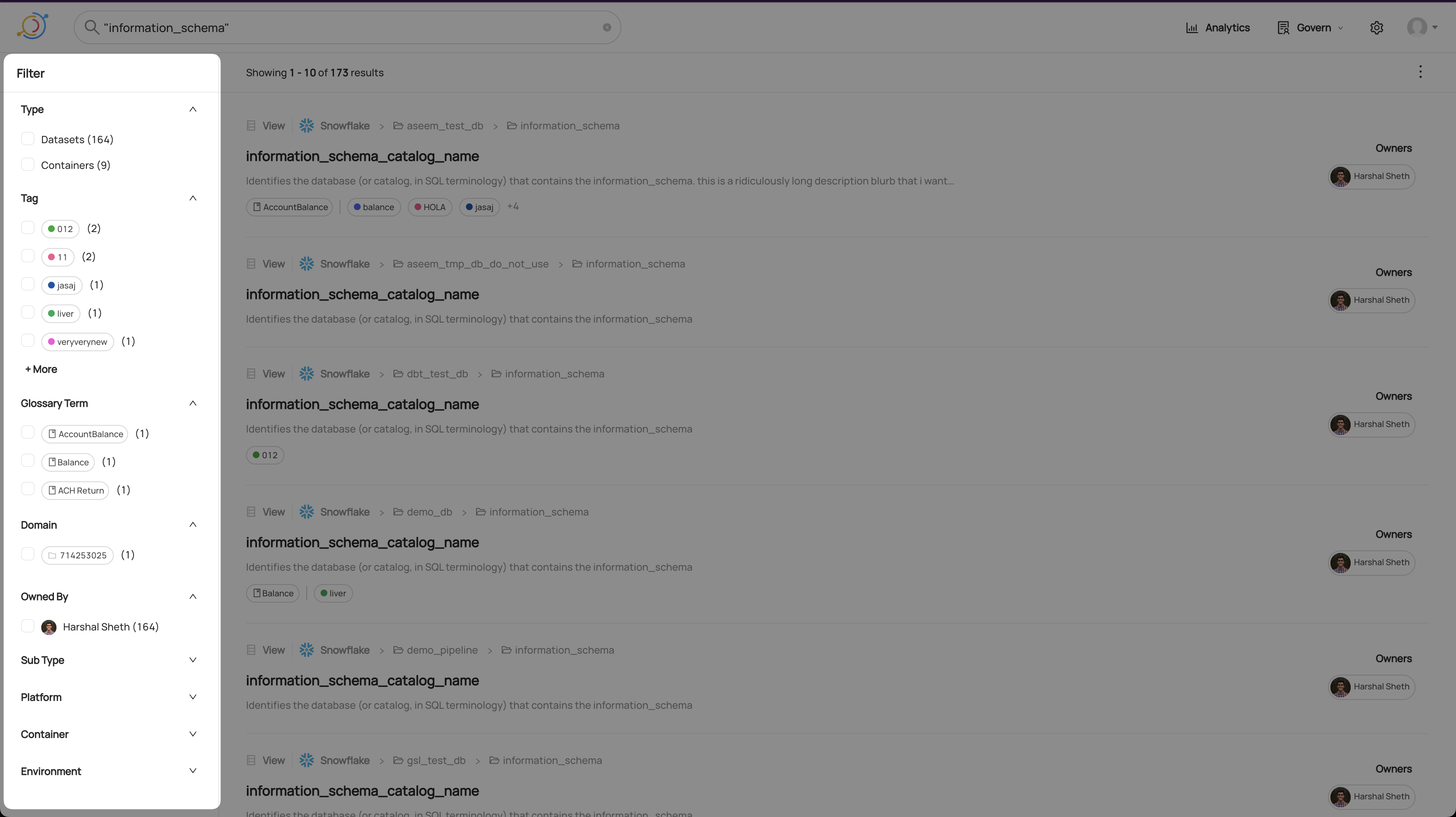
Advanced Filters
Using the Advanced Filter view, you can apply more complex filters. To get there, click 'Advanced' in the top right of the filter panel:
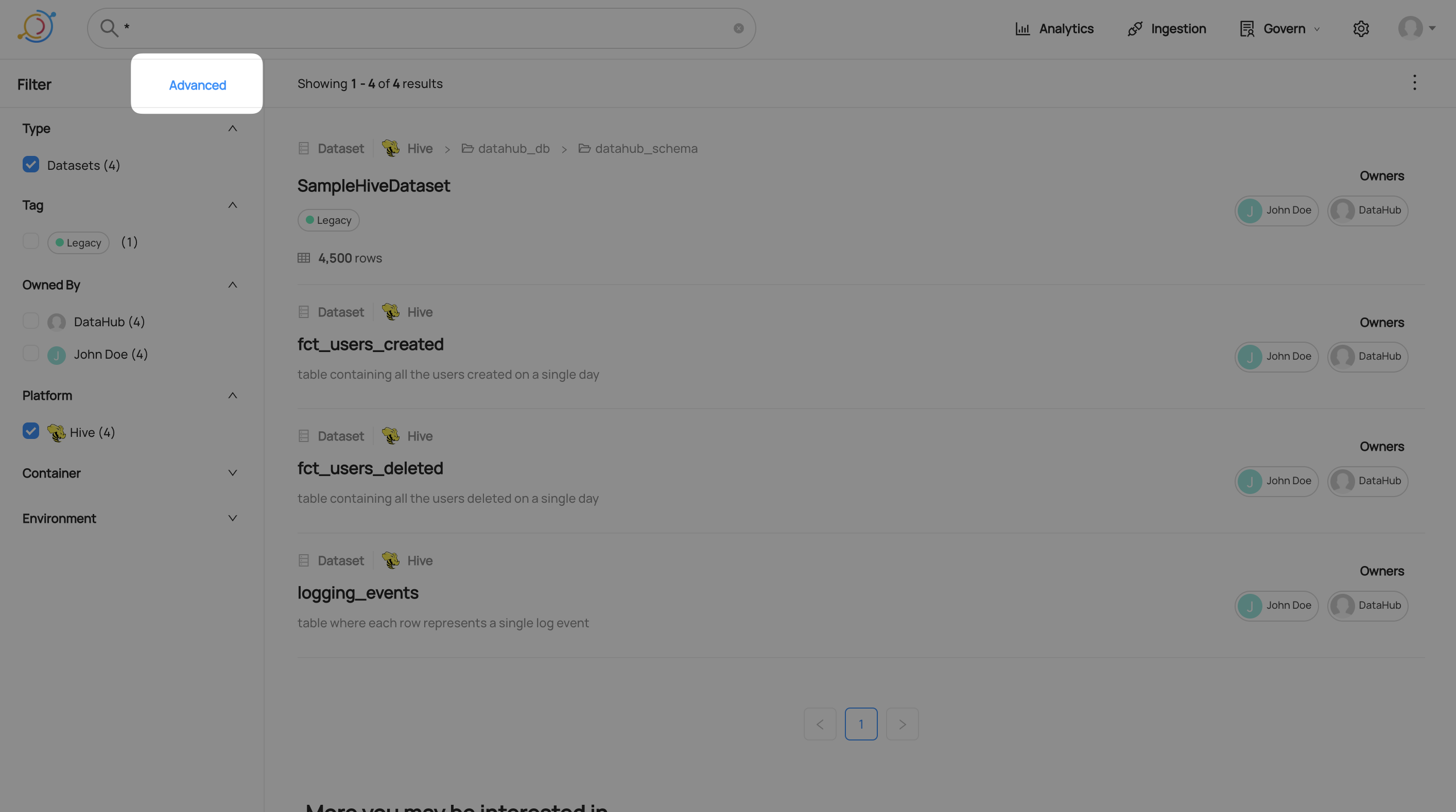
Adding an Advanced Filter
Currently, Advanced Filters support filtering by Column Name, Container, Domain, Description (entity or column level), Tag (entity or column level), Glossary Term (entity or column level), Owner, Entity Type, Subtype, Environment and soft-deleted status.
To add a new filter, click the add filter menu, choose a filter type, and then fill in the values you want to filter by.
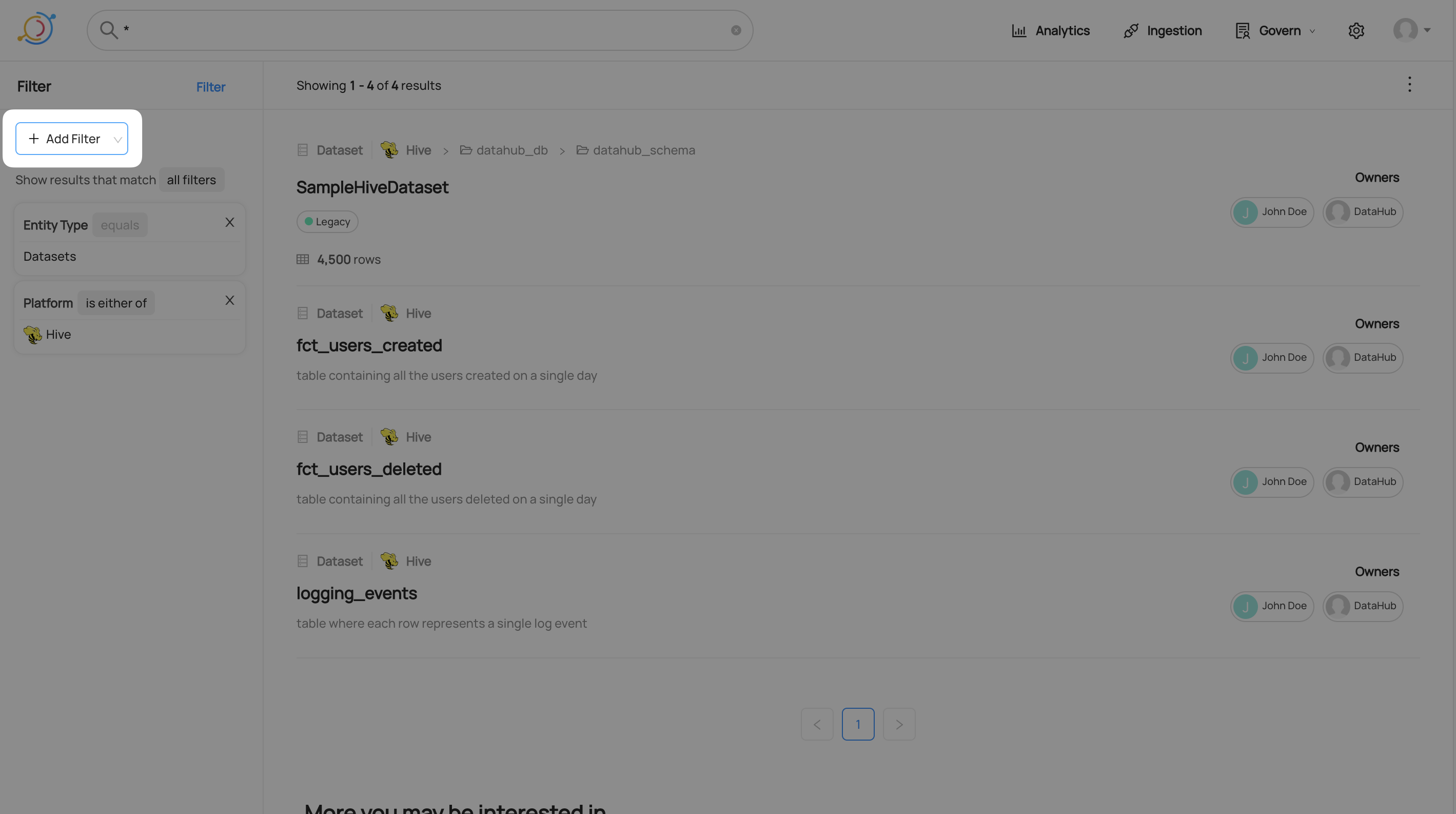
Matching Any Advanced Filter
By default, all filters must be matched in order for a result to appear. For example, if you add a tag filter and a platform filter, all results will have the tag and the platform. You can set the results to match any filter instead. Click on all filters and select any filter from the drop-down menu.
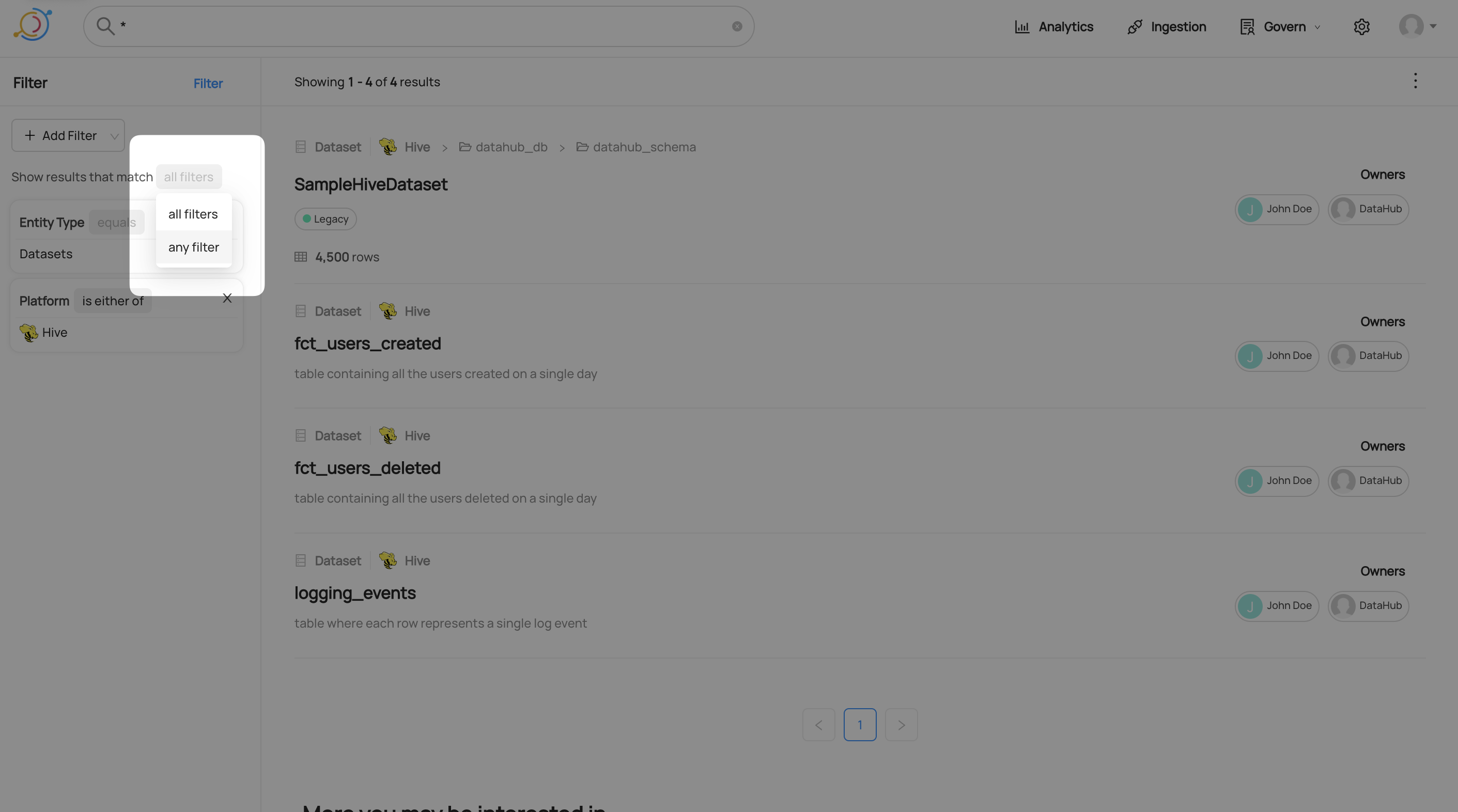
Negating An Advanced Filter
After creating a filter, you can choose whether results should or should not match it. Change this by clicking the operation in the top right of the filter and selecting the negated operation.

Results
Search results appear ranked by their relevance. In self-hosted DataHub ranking is based on how closely the query matched textual fields of an asset and its metadata. In Managed DataHub, ranking is based on a combination of textual relevance, usage (queries / views), and change frequency.
With better metadata comes better results. Learn more about ingestion technical metadata in the metadata ingestion guide.
Advanced queries
The search bar supports advanced queries with pattern matching, logical expressions and filtering by specific field matches.
The following are use cases with example search phrases. Additionally, an example link is provided for our demo instance. These examples are non exhaustive and using Datasets as a reference.
If you want to:
Exact match on term or phrase
"datahub_schema"Sample resultsdatahub_schemaSample results- Enclosing one or more terms with double quotes will enforce exact matching on these terms, preventing further tokenization.
Exclude terms
logging -snowflakeSample results- Results can be excluded by term using
-to negate the term.
Term boolean logic with precedence
logging + (-snowflake | os_audit_log)Sample results()can be used to set precedence of boolean term expressions
Find a dataset with the word mask in the name:
/q name: *mask*Sample results- This will return entities with mask in the name. Names tends to be connected by other symbols, hence the wildcard symbols before and after the word.
Find a dataset with a property, encoding
/q customProperties: encoding*Sample results- Dataset Properties are indexed in ElasticSearch the manner of key=value. Hence if you know the precise key-value pair, you can search using
"key=value". However, if you only know the key, you can use wildcards to replace the value and that is what is being done here.
Find a dataset with a column name, latitude
/q fieldPaths: latitudeSample results- fieldPaths is the name of the attribute that holds the column name in Datasets.
Find a dataset with the term latitude in the field description
/q editedFieldDescriptions: latitude OR fieldDescriptions: latitudeSample results- Datasets has 2 attributes that contains field description. fieldDescription comes from the SchemaMetadata aspect, while editedFieldDescriptions comes from the EditableSchemaMetadata aspect. EditableSchemaMetadata holds information that comes from UI edits, while SchemaMetadata holds data from ingestion of the dataset.
Find a dataset with the term logical in the dataset description
/q editedDescription: *logical* OR description: *logical*Sample results- Similar to field descriptions, dataset descriptions can be found in 2 aspects, hence the need to search 2 attributes.
Find a dataset which reside in one of the browsing folders, for instance, the hive folder
/q browsePaths: *hive*Sample results- BrowsePath is stored as a complete string, for instance
/datasets/prod/hive/SampleKafkaDataset, hence the need for wildcards on both ends of the term to return a result.
Videos
What can you do with DataHub?
GraphQL
- searchAcrossEntities
- You can try out the API on the demo instance's public GraphQL interface: here
The same GraphQL API that powers the Search UI can be used for integrations and programmatic use-cases.
# Example query
{
searchAcrossEntities(
input: {types: [], query: "*", start: 0, count: 10, filters: [{field: "fieldTags", value: "urn:li:tag:Dimension"}]}
) {
start
count
total
searchResults {
entity {
type
... on Dataset {
urn
type
platform {
name
}
name
}
}
}
}
}
DataHub Blog
FAQ and Troubleshooting
How are the results ordered?
The order of the search results is based on the weight what Datahub gives them based on our search algorithm. The current algorithm in OSS DataHub is based on a text-match score from Elasticsearch.
Where to find more information?
The sample queries here are non exhaustive. The link here shows the current list of indexed fields for each entity inside Datahub. Click on the fields inside each entity and see which field has the tag Searchable.
However, it does not tell you the specific attribute name to use for specialized searches. One way to do so is to inspect the ElasticSearch indices, for example:
curl http://localhost:9200/_cat/indices returns all the ES indices in the ElasticSearch container.
yellow open chartindex_v2_1643510690325 bQO_RSiCSUiKJYsmJClsew 1 1 2 0 8.5kb 8.5kb
yellow open mlmodelgroupindex_v2_1643510678529 OjIy0wb7RyKqLz3uTENRHQ 1 1 0 0 208b 208b
yellow open dataprocessindex_v2_1643510676831 2w-IHpuiTUCs6e6gumpYHA 1 1 0 0 208b 208b
yellow open corpgroupindex_v2_1643510673894 O7myCFlqQWKNtgsldzBS6g 1 1 3 0 16.8kb 16.8kb
yellow open corpuserindex_v2_1643510672335 0rIe_uIQTjme5Wy61MFbaw 1 1 6 2 32.4kb 32.4kb
yellow open datasetindex_v2_1643510688970 bjBfUEswSoSqPi3BP4iqjw 1 1 15 0 29.2kb 29.2kb
yellow open dataflowindex_v2_1643510681607 N8CMlRFvQ42rnYMVDaQJ2g 1 1 1 0 10.2kb 10.2kb
yellow open dataset_datasetusagestatisticsaspect_v1_1643510694706 kdqvqMYLRWq1oZt1pcAsXQ 1 1 4 0 8.9kb 8.9kb
yellow open .ds-datahub_usage_event-000003 YMVcU8sHTFilUwyI4CWJJg 1 1 186 0 203.9kb 203.9kb
yellow open datajob_datahubingestioncheckpointaspect_v1 nTXJf7C1Q3GoaIJ71gONxw 1 1 0 0 208b 208b
yellow open .ds-datahub_usage_event-000004 XRFwisRPSJuSr6UVmmsCsg 1 1 196 0 165.5kb 165.5kb
yellow open .ds-datahub_usage_event-000005 d0O6l5wIRLOyG6iIfAISGw 1 1 77 0 108.1kb 108.1kb
yellow open dataplatformindex_v2_1643510671426 _4SIIhfAT8yq_WROufunXA 1 1 0 0 208b 208b
yellow open mlmodeldeploymentindex_v2_1643510670629 n81eJIypSp2Qx-fpjZHgRw 1 1 0 0 208b 208b
yellow open .ds-datahub_usage_event-000006 oyrWKndjQ-a8Rt1IMD9aSA 1 1 143 0 127.1kb 127.1kb
yellow open mlfeaturetableindex_v2_1643510677164 iEXPt637S1OcilXpxPNYHw 1 1 5 0 8.9kb 8.9kb
yellow open .ds-datahub_usage_event-000001 S9EnGj64TEW8O3sLUb9I2Q 1 1 257 0 163.9kb 163.9kb
yellow open .ds-datahub_usage_event-000002 2xJyvKG_RYGwJOG9yq8pJw 1 1 44 0 155.4kb 155.4kb
yellow open dataset_datasetprofileaspect_v1_1643510693373 uahwTHGRRAC7w1c2VqVy8g 1 1 31 0 18.9kb 18.9kb
yellow open mlprimarykeyindex_v2_1643510687579 MUcmT8ASSASzEpLL98vrWg 1 1 7 0 9.5kb 9.5kb
yellow open glossarytermindex_v2_1643510686127 cQL8Pg6uQeKfMly9GPhgFQ 1 1 3 0 10kb 10kb
yellow open datajob_datahubingestionrunsummaryaspect_v1 rk22mIsDQ02-52MpWLm1DA 1 1 0 0 208b 208b
yellow open mlmodelindex_v2_1643510675399 gk-WSTVjRZmkDU5ggeFSqg 1 1 1 0 10.3kb 10.3kb
yellow open dashboardindex_v2_1643510691686 PQjSaGhTRqWW6zYjcqXo6Q 1 1 1 0 8.7kb 8.7kb
yellow open datahubpolicyindex_v2_1643510671774 ZyTrYx3-Q1e-7dYq1kn5Gg 1 1 0 0 208b 208b
yellow open datajobindex_v2_1643510682977 K-rbEyjBS6ew5uOQQS4sPw 1 1 2 0 11.3kb 11.3kb
yellow open datahubretentionindex_v2 8XrQTPwRTX278mx1SrNwZA 1 1 0 0 208b 208b
yellow open glossarynodeindex_v2_1643510678826 Y3_bCz0YR2KPwCrrVngDdA 1 1 1 0 7.4kb 7.4kb
yellow open system_metadata_service_v1 36spEDbDTdKgVlSjE8t-Jw 1 1 387 8 63.2kb 63.2kb
yellow open schemafieldindex_v2_1643510684410 tZ1gC3haTReRLmpCxirVxQ 1 1 0 0 208b 208b
yellow open mlfeatureindex_v2_1643510680246 aQO5HF0mT62Znn-oIWBC8A 1 1 20 0 17.4kb 17.4kb
yellow open tagindex_v2_1643510684785 PfnUdCUORY2fnF3I3W7HwA 1 1 3 1 18.6kb 18.6kb
The index name will vary from instance to instance. Indexed information about Datasets can be found in:
curl http://localhost:9200/datasetindex_v2_1643510688970/_search?=pretty
example information of a dataset:
{
"_index" : "datasetindex_v2_1643510688970",
"_type" : "_doc",
"_id" : "urn%3Ali%3Adataset%3A%28urn%3Ali%3AdataPlatform%3Akafka%2CSampleKafkaDataset%2CPROD%29",
"_score" : 1.0,
"_source" : {
"urn" : "urn:li:dataset:(urn:li:dataPlatform:kafka,SampleKafkaDataset,PROD)",
"name" : "SampleKafkaDataset",
"browsePaths" : [
"/prod/kafka/SampleKafkaDataset"
],
"origin" : "PROD",
"customProperties" : [
"prop2=pikachu",
"prop1=fakeprop"
],
"hasDescription" : false,
"hasOwners" : true,
"owners" : [
"urn:li:corpuser:jdoe",
"urn:li:corpuser:datahub"
],
"fieldPaths" : [
"[version=2.0].[type=boolean].field_foo_2",
"[version=2.0].[type=boolean].field_bar",
"[version=2.0].[key=True].[type=int].id"
],
"fieldGlossaryTerms" : [ ],
"fieldDescriptions" : [
"Foo field description",
"Bar field description",
"Id specifying which partition the message should go to"
],
"fieldTags" : [
"urn:li:tag:NeedsDocumentation"
],
"platform" : "urn:li:dataPlatform:kafka"
}
},
Need more help? Join the conversation in Slack!
